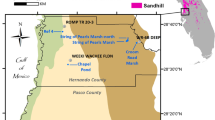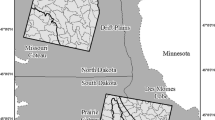Abstract
The sandhill wetlands, ponds, and lakes of west-central Florida, USA, are an understudied, poorly understood variant of geographically isolated features. Their karst origin and xeric setting impart a characteristic ecohydrology, which has been attributed to their apparent connectivity to a regional water-supply aquifer. This study uses physical and geochemical hydrologic data to provide evidence of this connectivity. The findings presented here debut these rare features, which advances their fundamental understanding at a time when increasing anthropogenic pressures risk further loss and degradation. From these findings, the hydrologic nature of sandhill wetlands, ponds and lakes is characterized, which may be useful in distinguishing them from others with different hydrologic controls and for identifying features of similar connectivity, karst or otherwise, wherever they may be found. Water levels and/or geochemistry were compared for 12 wetlands, five ponds, two lakes, and 12 monitor wells (10 constructed in limestone, two in surficial sand) in west-central Florida. Hydrograph and regression analyses indicate similar widely ranging water levels (2–5 m) for sandhill features and wells that are both analogous in elevation and highly correlated with each other (0.84 ≤ R2 ≤ 0.99). Sandhill feature geochemistry also reflects that of the monitor wells, varying relative to the depth of the rainwater-limestone water mixing zone. Findings here suggest sandhill wetland/water features are surface water expressions of the underlying unconfined regional aquifer hydrology, distinguishing them from isolated features elsewhere and establishing them as a groundwater endmember along the hydrologic continuum.















Similar content being viewed by others
Data Availability
The datasets generated during and/or analyzed during the current study are available from the corresponding author on reasonable request.
Code Availability
Not applicable.
References
Addinsoft (2019) XLSTAT statistical and data analysis solution. Boston, USA. https://www.xlstat.com.
Arguez A, Durre I, Applequist S, Squires M, Vose R, Yin X, Bilotta R (2010) NOAA’s U.S. Climate Normals (1981–2010) BROOKSVILLE HERNANDO CO AIRPORT, FL US. NOAA National Centers for Environmental Information. Doi:https://doi.org/10.7289/V5PN93JP.
Arthur JD, Fischler C, Kromhout C, Clayton J, Kelley GM, Lee RA, Li L, O’Sullivan M, Green R, Werner C (2008) Hydrogeologic framework of the Southwest Florida Water Management District. Florida Geological Survey Bulletin 68: 175
Barbieri M (2019) Isotopes in hydrology and hydrogeology. Water 11(2):291
Basso R (2004) Hydrogeologic setting of lakes within the Northern Tampa bay region: Brooksville, Southwest Florida Water Management District (SWFWMD) Technical Memorandum (November 9), 27 p.
Bidlake WR, Woodham WM, Lopez MA (1993) Evapotranspiration from areas of native vegetation in west-central Florida. No. 9–415. US Geological Survey; USGS Earth Science Information Center, Open-File Reports Section [distributor].
Blood ER, Phillips JS, Calhoun D, Edwards S (1997) The role of the Floridan Aquifer in depressional wetlands hydrodynamics and hydroperiod. Georgia Institute of Technology.
Brooks RT (2004) Weather-related effects on woodland vernal pool hydrology and hydroperiod. Wetlands 24(1):104–114
CH2MHill (2005) Preliminary Evaluation Criteria in Support of Minimum Flows and Levels for Sandhill Lakes. Technical Pub. SJ2005-SP7 Palatka, Fla.: St. Johns River Water Management District.
Cohen MJ et al (2016) Do geographically isolated wetlands influence landscape functions? Proc Natl Acad Sci 113(8):1978–1986
Florida Fish & Wildlife Conservation Commission and Florida Natural Areas Inventory. Cooperative Land Cover Version 3.2 Vector. Tallahassee, FL. 2013.
Craig H (1961) Isotopic variations in meteoric waters. Science 133(3465):1702–1703
Deevey ES Jr (1988) Estimation of downward leakage from Florida lakes. Limnol Oceanogr 33(6):1308–1320
Edwards AL, Sharitz RR (2000) Population genetics of two rare perennials in isolated wetlands: Sagittaria isoetiformis and S. teres (Alismataceae). Am J Bot 87(8):1147–1158
Florida Department of Environmental Protection (FDEP) (1998) Geology, Bedrock, Geomorphology. White, Puri and Vernon Physiographic Map of Florida. 1:24000 (1in=2000ft) scale.
Florida Department of Environmental Protection (FDEP) (2018) Upper Floridan Aquifer Potentiometric Surface May 2015. Accessed November 21, 2020. https://ca.dep.state.fl.us/arcgis/rest/services/OpenData/FGS_POTMAP_MAY_2015/ImageServer
Ginsberg M (1985) Nebraska’s sandhills lakes: a hydrogeologic overview. J Am Water Res Assoc 21(4):57–578
Hayashi M, van der Kamp G, Rosenberry DO (2016) Hydrology of prairie wetlands: understanding the integrated surface-water and groundwater processes. Wetlands 36(2):237–254
Heliotis FD, DeWitt CB (1987) Rapid water table responses to rainfall in a northern peatland ecosystem. J Ame Water Res Assoc 23(6):1011–1016
Henderson SE (1986) Hydrology of Hunters Lake, Hernando County, Florida. No. 85–4242.
Waterloo Hydrogeologic, Inc. (2020) AquaChem 2014.2 User’s Manual. Waterloo, ON.
Jones Edmunds & Associates (2006) Sandhill Lakes Minimum Flows and Levels: values, functions, criteria, and threshold for establishing and supporting minimum levels. St. Johns River Water Management District, Palatka, FL.
Knowles Jr L, Phelps GG, Kinnaman SL, German ER (2005) Hydrologic response in karstic-ridge wetlands to rainfall and evapotranspiration, central Florida, 2001–2003.
Large A et al (2007) Using long-term monitoring of fen hydrology and vegetation to underpin wetland restoration strategies. Appl Veg Sci 10(3):417–428
Lee TM, Swancar A (1997) Influence of evaporation, ground water, and uncertainty in the hydrologic budget of Lake Lucerne, a seepage lake in Polk County, Florida. Vol. 2439. US Government Printing Office.
Lee TM, Haag KH, Metz PA, Sacks LA, County P, Tampa Bay Water (2009) Comparative Hydrology, Water Quality, and Ecology of Selected Natural and Augmented Freshwater Wetlands in West-Central Florida.
Leibowitz SG, Nadeau T (2003) Isolated wetlands: state-of-the-science and future directions. Wetlands 23(3):66–684
Lide RF, Meentemeyer VG, Pinder JE, Beatty LM (1995) Hydrology of a Carolina bay located on the upper coastal plain of western South Carolina. Wetlands 15(1):47–57
Miller JA (1990) Ground water atlas of the United States: segment 6, Alabama, Florida, Georgia, South Carolina. No. 730-G. US Geological Survey.
Novitzki RP, Smith RD, and Fretwell JD (1996) Wetland functions, values, and assessment in National water summary on wetland resources—selected articles. US Geological Survey Water-Supply Paper 2425.
Nowicki RS "The Peculiar Nature of Florida’s Sandhill Wetlands, Ponds & Lakes— Their Ecohydrology, Relationship with the Regional Aquifer & Importance within the Landscape." (2019). Graduate Theses and Dissertations. https://scholarcommons.usf.edu/etd/8064
O’Driscoll MA, Parizek RR (2008) Geological controls on seasonal-pool hydroperiod in a karst setting. Wetlands 28(4):1004–1017
Rains MC (2011) Water sources and hydrodynamics of closed-basin depressions, Cook Inlet Region, Alaska. Wetlands 31(2):377–387
Rains MC, Fogg GE, Harter T, Dahlgren RA, Williamson RJ (2006) The role of perched aquifers in hydrological connectivity and biogeochemical processes in vernal pool landscapes, Central Valley California. Hydrol Process 20(5):1157–1175
Rains MC, Dahlgren RA, Fogg GE, Harter T, Williamson RJ (2008) Geological control of physical and chemical hydrology in California vernal pools. Wetlands 28(2):347–362
Reddy C (2018) Understanding the concept of hierarchical clustering technique. Towards Data Science. https://towardsdatascience.com/understanding-the-concept-of-hierarchical-clustering-technique-c6e8243758ec. Accessed 27 December 2018.
Sacks LA, Lee TM, Radell MJ (1994) Comparison of energy-budget evaporation losses from two morphometrically different Florida seepage lakes. J Hydrol 156(1–4):311–334
Sacks LA, Swancar A, Lee TM (1998) Estimating ground-water exchange with lakes using water-budget and chemical mass-balance approaches for ten lakes in ridge areas of Polk and Highlands Counties, Florida. Vol. 98. No. 4133. US Department of the Interior, US Geological Survey.
Schlising RA, Sanders EL (1982) Quantitative analysis of vegetation at the Richvale vernal pools, California. Am J Bot 69(5):734–742
Shannon EE, Brezonik PL (1972) Limnological characteristics of north and central Florida lakes 1. Limnol Oceanogr 17(1):97–110
Southwest Florida Water Management District (SWFWMD). Rainfall total for 21033 Chassahowitzka. Water Management Information System. http://www18.swfwmd.state.fl.us/ResData/Search/ExtResourceData.aspx?site=21033&Parameter=1&ParameterType=H. Accessed 23 March 2018.
Southwest Florida Water Management District (SWFWMD). Rainfall total for 23403 Richloam Tower. Water Management Information System. http://www18.swfwmd.state.fl.us/ResData/Search/ExtResourceData.aspx?site=23403&Parameter=1&ParameterType=H. Accessed 23 March 2018.
Southwest Florida Water Management District (SWFWMD). Water elevation NAVD88 for 20120 ROMP TR 20–3 U Fldn AQ (OCAL) MONITOR. Water Management Information System. http://www18.swfwmd.state.fl.us/ResData/Search/ExtResourceData.aspx?site=20120&Parameter=44&ParameterType=H. Accessed 23 March 2018.
Southwest Florida Water Management District (SWFWMD). Water elevation NAVD88 for 20727 ROMP 107 U Fldn AQ MONITOR. Water Management Information System. http://www18.swfwmd.state.fl.us/ResData/Search/ExtResourceData.aspx?site=20727&Parameter=44&ParameterType=H&SM=1&ResView=1. Accessed 18 July 2018.
Southwest Florida Water Management District (SWFWMD). Water elevation NAVD88 for 20841 ROMP 97 U Fldn AQ MONITOR. Water Management Information System. http://www18.swfwmd.state.fl.us/ResData/Search/ExtResourceData.aspx?site=20841&Parameter=44&ParameterType=H&SM=1&ResView=1. Accessed 18 July 2018.
Southwest Florida Water Management District (SWFWMD). Water elevation NAVD88 for 23542 WR-6B DEEP U Fldn AQ MONITOR. Water Management Information System. http://www18.swfwmd.state.fl.us/ResData/Search/ExtResourceData.aspx?site=23542&Parameter=44&ParameterType=H. Accessed 18 July 2018.
Southwest Florida Water Management District (SWFWMD). Water Use Permit Issued to the Hernando County BOCC. August 25, 2015.
Swancar A, Lee TM, O’Hare TM (2000) Hydrogeologic setting, water budget, and preliminary analysis of ground-water exchange at Lake Starr, a seepage lake in Polk County, Florida. No. 2000-4030. US Department of the Interior, US Geological Survey; Branch of Information Services [distributor].
Swancar A, Lee TM (2003) Effects of recharge, Upper Floridan aquifer heads, and time scale on simulated ground-water exchange with Lake Starr, a seepage lake in central Florida. Water Res Invest Rep 2:4295
Tiner RW (2003) Geographically isolated wetlands of the United States. Wetlands 23(3):494–516
Tsai J, Venne LS, McMurry ST, Smith LM (2007) Influences of land use and wetland characteristics on water loss rates and hydroperiods of playas in the Southern High Plains, USA. Wetlands 27(3):68–692
Uden DR et al (2014) The role of reserves and anthropogenic habitats for functional connectivity and resilience of ephemeral wetlands. Ecol Appl 24(7):1569–1582
United States Geologic Survey. USGS Groundwater Daily Data for the Nation. USGS 283201082315601 WEEKI WACHEE WELL NEAR WEEKI WACHEE FL. https://waterdata.usgs.gov/nwis/dv/?site_no=283201082315601&agency_cd=USGS&referred_module=gw. Accessed 23 March 2018.
Upchurch S, Scott TM, Alfieri M, Fratesi B, Dobecki TL (2018) The Karst Systems of Florida: Understanding Karst in a Geologically Young Terrain. Springer, Cham
Ward JH Jr (1963) Hierarchical grouping to optimize an objective function. J Am Stat Assoc 58(301):236–244
Weeks EP (2002) The Lisse Effect Revisited Groundwater 40(6):652–656
Wetzel RG (2001) Limnology: lake and river ecosystems. Gulf professional publishing, Houstan
White WA (1970) Geomorphology of the Florida peninsula.
Wilcox DA, Shedlock RJ, Hendrickson WH (1986) Hydrology, water chemistry and ecological relations in the raised mound of Cowles Bog. J Ecol 74:1103–1117
Winter TC, Harvey JW, Franke OL, Alley WM (1998) Ground water and surface water: a single resource (Vol. 1139) US Geological Survey.
Wolfe WJ (1996) Hydrology and tree-distribution patterns of karst wetlands at Arnold Engineering Development Center, Tennessee. US Department of the Interior, US Geological Survey.
Acknowledgements
Special thanks to Mark Morgan, PE, and the Hernando County Utilities Department who, by way of a subcontract from WSP USA, Inc., provided funding for the monitoring of wetlands during this study and to Jeffrey Trommer, PG, for the inspiring hydrogeologic dialogue during this time. Gratitude to Dr. Zachary Atlas and the University of South Florida (USF) Center for Geochemical Analysis Laboratory for ion analyses and to Jessica Wilson and the USF Stable Isotope Lab for isotope analyses. Additional thanks to the USF students who assisted during the field and/or laboratory sampling: Tim Fallon, Dr. Hilary Flower, Laura Lotero, and Dana Noble. Funding for laboratory analyses was provided in part by the Fred L. & Helen M. Tharp Endowed Scholarship Fund.
Funding
Funding for the monitoring of wetlands during this study was provided by the Hernando County Utilities Department by way of a subcontract from WSP USA, Inc. Funding for laboratory analyses was provided in part by the Fred L. & Helen M. Tharp Endowed Scholarship Fund.
Author information
Authors and Affiliations
Contributions
MR and RN contributed to the study conception and design. Material preparation and field data collection were performed by RN, MR, and JL. MP provided geochemical review and analytical support. The first draft of the manuscript was written by RN, with support from JL and MR. All authors read and approved the final manuscript.
Corresponding author
Ethics declarations
Conflict of interest
Not applicable.
Ethical Approval
Not applicable.
Consent to Participate
Not applicable.
Consent for Publication
Not applicable.
Additional information
Publisher’s Note
Springer Nature remains neutral with regard to jurisdictional claims in published maps and institutional affiliations.
Rights and permissions
About this article
Cite this article
Nowicki, R.S., Rains, M.C., LaRoche, J.J. et al. The Peculiar Hydrology of West-Central Florida’s Sandhill Wetlands, Ponds, and Lakes—Part 1: Physical and Chemical Evidence of Connectivity to a Regional Water-Supply Aquifer. Wetlands 41, 113 (2021). https://doi.org/10.1007/s13157-021-01493-8
Received:
Accepted:
Published:
DOI: https://doi.org/10.1007/s13157-021-01493-8




